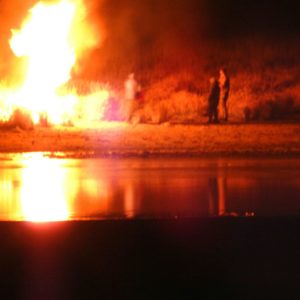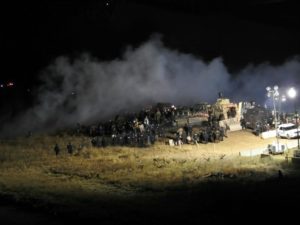Mandan, N.D. — North Dakotans are no strangers to road closures. Nearly every winter, blizzards and bad weather force shutdowns on Interstate 94 as it runs across the high plains. However, the closures on Sunday night were something altogether different. National Guard members and a local sheriff in a bulletproof vest stopped motorists attempting to travel between Bismarck and the site of the Dakota Access Pipeline protest.
Citing “activity” up ahead, the sheriff asked drivers to turn around and find alternate routes. This being North Dakota, it required backtracking nearly to Mandan, some 40 miles away. During the drive, a steady stream of police vehicles raced down Highway 1806 headed for Backwater Bridge, a site slightly north of one of the DAPL protest camps.
Information about the incident is patchy, since access to the site was extremely limited on Sunday. In a press release, area law enforcement called the event “a riot,” reporting that nearly 400 protesters were “on the bridge and attempting to breach the bridge to go north on highway 1806.”
Backwater Bridge has been blocked for several weeks since protesters were pushed off of private property and on to Army Corps land on the other side of the river. The movement last night was an attempt by protesters to regain the lost ground. Protesters tried to push through the police line, using heavy equipment to shift several burned out vehicles to try to gain better access to the bridge.
Drew Wrigley, North Dakota’s Lieutenant Governor, agreed that protesters were ramping up the violence and called the “code red” event on Sunday a riot.
“This was not a ‘clash’ with police,” Wrigley said on Monday. “Four hundred rioting protesters attacked police.”
“For about five hours, the results were not a foregone conclusion,” Wrigley said, describing his experience watching events play out from the police command center.
During the riot, protesters showered police with fragments of burning logs and threw rocks at police. Despite the violence, Wrigley pushed back on the claim by protesters that police used a water cannon in subzero temperatures.
“It’s not a water cannon. It’s not a crowd control device. It was a fire hose,” he said.
On Sunday night, protesters started at least 3 fires as a means of pressuring law enforcement back from the bridge. The fires were a continuation of a tactic that the protesters have used over the course of the last few weeks. Those set on Sunday were serious enough to threaten the structural integrity of the bridge, which remains closed until it has passed a formal inspection.
But in the interview, Wrigley also expressed his frustration with the Army Corps’ reticence to order the protesters removed. Since the camp is on federal land, state officials cannot evict the protesters, no matter how violent they become. Now, as they wait for a final decision on the pipeline, the state of North Dakota is forced to spend millions to allow the protests to continue.
“Through the use of the men and women in law enforcement from across the state, North Dakota National Guard, and peace officer troops brought in from other neighboring states all working in unison, the unlawful rioting protesters were pushed off of every inch of land that we have the lawful authority over,” he said.
Like many other North Dakotans, Wrigley expressed his frustration with the federal government which both refuses to remove the protesters and also has sent little to assist law enforcement in North Dakota. With the threat of escalation on their hands, the state of North Dakota is doing all it can to try to shift manpower to the area, but Wrigley acknowledges that resources are stretched thin, particularly as smaller sympathy protests pop up in other areas.
The bridge remained in the control of protesters Monday afternoon, but the group was no longer engaging the police force.
On Monday morning, protest supporters condemned the move and called for “the immediate cessation of use of water cannons,” citing the temperatures in the mid twenties and “no means of active rewarming in these conditions.” They claim that 167 people were injured on Sunday night and have put out a call for medical supplies. An additional 17 people were taken by ambulance to Bismarck and Fort Yates.
Protesters have also complained that the crowd control tactics hurt “medics” on site. The term “medic” is loosely applied by the protesters to those who offer “medical/healing aid” to the camp. It includes “qualified medics, EMTs, nurses, physicians, herbalists, midwives, massage therapists.” So far the camp has not made a formal effort to verify training or credentials for anyone claiming to operate as a medic and medics are not always identifiable by their badges or clothing.
The claims of peaceful demonstration contradict both statements from police and an earlier post on the protest group’s Facebook page, which said that “Water protectors are done with the military-style barricades. We are done with the flood lights and the armored military trucks. We are are done with it!” and asked those interested to gather to help open up the bridge. Police consider the vehicles–two police trucks burned by protesters several weeks ago–a line which keeps the protest from spilling on to private property.
Because of the bridge closure, access to the camp from the north remains restricted.


